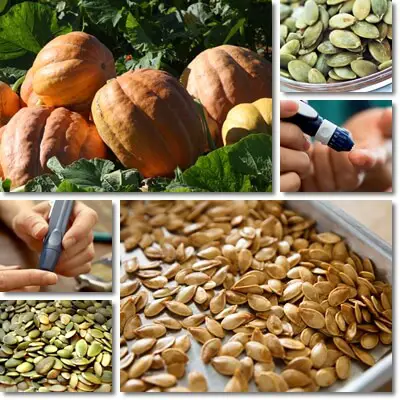As a diabetic, you can eat pumpkin seeds with your condition in modest amounts. Pumpkin seeds have a low glycemic index which means they have minimal effects on blood sugar levels. Moreover, they are low in carbohydrates and sugar and high in fiber, protein and fat, all aspects of nutrition that work synergically towards better blood sugar control and improved insulin sensitivity whilst preventing fluctuations in blood sugar levels. Side effects may occur only with excessive intake over longer periods of time and include weight gain and associated complications, including insulin resistance and cardiovascular problems.
The aspects of pumpkin seeds nutrition most relevant to diabetes include the following macronutrient facts (values may differ depending variety, moisture content or any processing undergone):
1) Energetic value – Calories: 570 kcal/100 g of kernels
2) Carbohydrates: 13-15 g of carbs of which 6.5 g dietary fiber
3) Protein: 23-30 g
4) Fat: 43-49 g of which 8-9 g saturated fat and 34-35 g to 40-41 g healthy unsaturated fat
5) Rich in B vitamins, especially B2, B3, B5 and B9
6) Rich in minerals: notably iron, magnesium and zinc and a good source of potassium

Do pumpkin seeds raise blood sugar?
Yes, they do, but the rise in blood sugar they produce is minimal. 100 g of pumpkin seeds contain 13-15 g g of carbohydrates. About 6.5 g of the total carb content is made of indigestible dietary fiber and only 6.5-8.5 digestible carbohydrates. Digestible carbohydrates are broken down into their simplest form which is sugar, which is then absorbed into the bloodstream and contributes to what is colloquially known as blood sugar levels. Fortunately, the rise is modest, slow and steady which means the end effect on blood sugar metabolism is minimal. All thanks to a low glycemic index value.
Pumpkin seeds glycemic index: 10 (low)
The glycemic index (GI) is a scale that classifies foods according to their effects on blood sugar, or how fast or slow they raise blood sugar levels. Below 55 is a low GI. Between 55-69 is a moderate GI. Over 70 is a high GI. Foods with a low GI are good for diabetics to eat because they hold minimal effects on blood sugar metabolism. The lower the GI, the better. Also see Can Diabetics Eat Pumpkin?
What makes pumpkin seeds a low glycemic food is the low carbohydrate content, good fiber and high protein and fat values. A low carb content (13-15 g of which only 6.5-8.5 g digestible carbohydrates) means blood sugar levels don’t go up too much. Fiber (6.5 g) is not digestible and thus slows down the entire digestion process and the rate of sugar absorption into the bloodstream. As a result, it contributes to a steadier rise in blood sugar levels and prevents extreme fluctuations. Lastly, fat and protein take longer to be digested compared to carbs and lengthen all of digestion. This causes the sugar obtained from the carbohydrates in the seed kernels to be released into the bloodstream more slowly, hence the low glycemic index values.

What is a good serving size for pumpkin seeds if you have diabetes?
Despite being a low glycemic food with minimal effects on blood sugar, pumpkin seeds serving size should be limited to amounts as modest as 28-30 g at most. The reason for this restriction on intake is that the kernels are a significant source of fat and calories and will promote weight gain if eaten in excess. And weight gain is bad for diabetes as it accentuates insulin resistance, favors cardiovascular disease and limits physical activity.
A serving of 30 g of the kernels will provide about 170 kcal and between 12.9 and 14.7 g of fat as well as good amounts of vitamins B2, B5 and B9, potassium and excellent amounts of iron, magnesium, manganese, phosphorus and zinc. Of course, this amount is but a crude generalization.
Ideally, all diabetics should see a doctor or a dietitian with experience in diabetic diets and get a personalized eating plan that includes recommendations for maximum intakes of carbohydrates and fat per day and per meal. This will allow them to plan their meals ahead to include favorite foods such as pumpkin seeds or fruit without exceeding their nutritional requirements.
Pumpkin seeds side effects for diabetes
From a nutritional point of view, pumpkin seeds are good for diabetes because they provide small amounts of digestible carbohydrates, but don’t affect blood sugar very much, when eaten in modest amounts of course. They are only bad for diabetes if eaten in excess. Over time, over-eating may lead to weight gain and worsen insulin resistance and glucose tolerance.
Weight gain poses risks for cardiovascular health as well both by limiting the diabetic patient’s mobility and ability to engage in physical activity and by causing chronic disease in the form of atherosclerosis and ensuing complications. If the seeds are salted, then the added salt will likely contribute to high blood pressure.
Pumpkin seeds can cause stomach pain if eaten in excess as fiber accumulates and leads to stomach upset, possibly also diarrhea. To avoid stomach upset, it helps to only eat the olive kernels and discard the cream shells. Unless shelled before hand, there is a chance pumpkin seeds may get stuck in the throat (see Pill Stuck in Throat Feeling: Causes, Treatment and Solutions) or accidentally get aspirated into the lungs (see Food Aspiration into Lungs: Causes, Symptoms and Treatment).
Roasted pumpkin seeds and diabetes
Roasted pumpkin kernels lose some of their moisture and concentrate nutrients compared to the raw kernels. Differences are minute, almost insignificant, except for vitamin C which is lost almost entirely in the roasted seeds due to exposure to heat. Other than this, whether you choose to eat the raw or roasted kernels, you will be getting about the same effects on diabetes.
Ideally, it’s best to avoid salting the seed kernels because salt raises blood pressure which is not good (hypertension is a common complication of diabetes). Also avoid adding butter or vegetable oils. The kernels are already high in fat (some varieties are 50% fat) and more will just increase their energetic value unnecessarily. Instead, you can boost taste with seasonings such as cinnamon for a sweet and slightly piquant savor, ginger or garlic for a spicy, stinging flavor that completely makes up for the lack of salt and coriander (or cilantro), cardamom, cloves and cumin for something of a more special taste.
